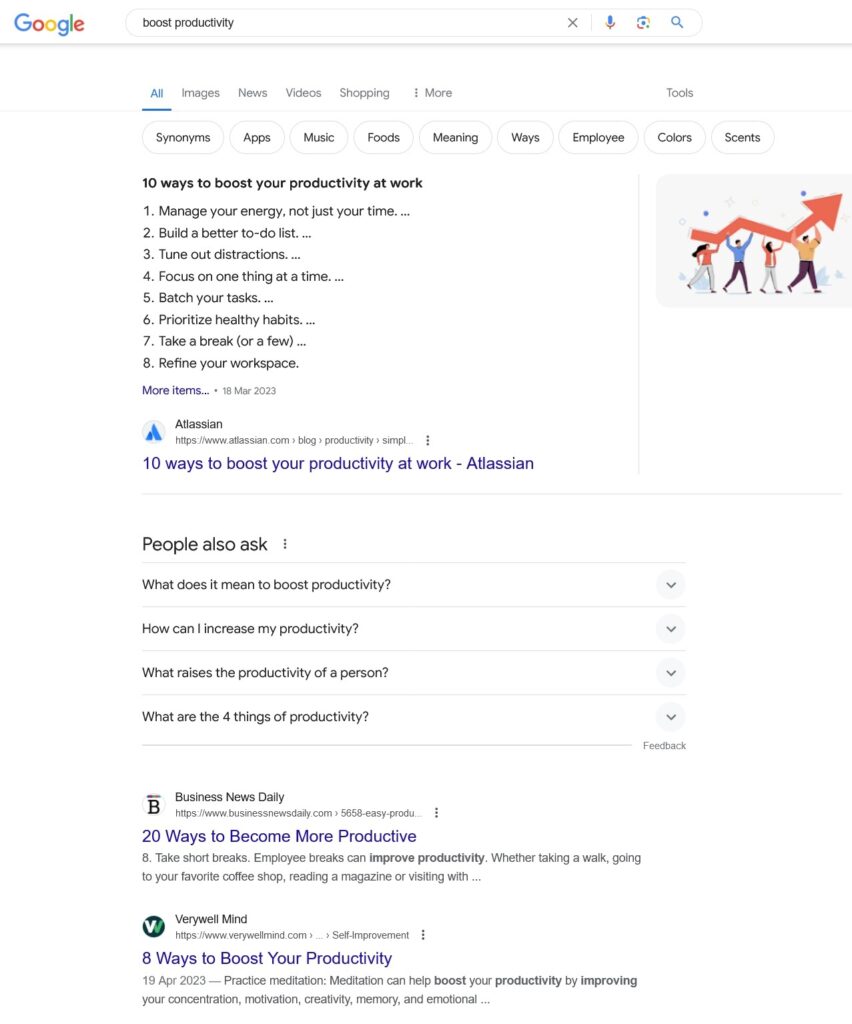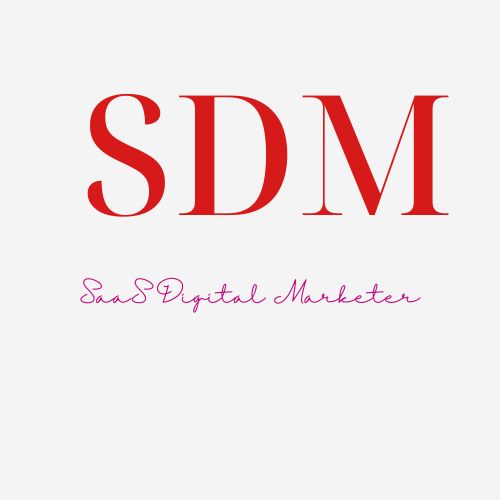Google is constantly updating its algorithms to improve search results. However, one thing that remains unchanged is its focus on delivering high-quality content that meets searchers’ intent, answers their questions, and is easy to consume. In other-words, content written for people, not search engines.
Create people-first content, and your rankings will naturally follow.
A Guide to Creating People-First Content
Google’s algorithm updates keep website owners on their toes, always posing the risk of disrupting rankings. Fortunately, there’s an effective strategy to stay ahead: focusing on people-first content.
People-first content meets most of Google’s quality criteria, helping you satisfy both user needs and search engine requirements. By prioritizing genuine value and relevance, you create a solid foundation for maintaining and even enhancing your rankings.
Additionally, you earn your target audience’s trust as a dependable source of valuable insights within your industry.
In this comprehensive guide, you’ll discover tips for creating helpful, reliable people-first content that aligns with Google’s quality standards to improve your search rankings.
Why You Should Prioritize Creating People-First Content
Creating people-first content is a powerful way to position your brand as a trusted authority within your niche. By consistently delivering valuable and relevant information, you not only build trust but also encourage repeat visits and nurture lasting brand loyalty.
Over time, your audience begins to seek your insights, advice, and updates directly through your website, email, or social media channels.
The cumulative result of this is:
- Higher conversion rates
- Lower churn
- Stronger brand reputation
- Better client relationships
Additionally, people-first content excels in search engines due to its ability to drive higher engagement and naturally incorporate relevant keywords.
5 User-Centric Content Strategies for Maximum Engagement and SEO Success
Use these tactics to create content that your audience loves and Google ranks favorably.
1. Get Inside Your Audience’s Head
Ever tried picking a special gift for someone you barely know? It’s hard to get it right without understanding their tastes. The same goes for your website content—it’s challenging to impress your readers when you don’t know them.
To truly connect, understand who your readers are, what excites them, and what frustrates them.
This understanding is key to crafting content that truly connects with your audience in the right tone and language. Research shows that 76% of consumers expect brands to demonstrate that they understand their frustrations and priorities.
Your current customer base is an ideal representation of the kind of audience that would be most interested in your content. Use it to guide your content creation strategy.
If you don’t have a buyer persona, create one. A buyer persona is a detailed and accurate representation of your ideal customer. It’s derived from the analysis of data and insights gathered from market research and real data about existing customers.
To create a buyer persona, use these steps:
- Gather data: Collect information about your existing customers through surveys, interviews, website analytics, CRM data, and social media insights.
- Identify patterns: Look for common characteristics and behaviors among your customers, including behavior patterns, goals, challenges, and buying motivations. Group them into segments based on similarities.
- Create personas: Develop detailed profiles for each segment, including a name, avatar, demographics, job role, goals, challenges, and preferred communication channels. Each profile should accurately represent a specific segment.
Here’s an example.

Image source: HubSpot
Once you have your personas in place, let them guide you in creating content that connects with the target audience’s preferences, interests, and needs. Tailor each piece of content to a particular persona.
Pro tip: HubSpot has a free Make My Persona tool you can use to create accurate buyer personas.
2. Provide Immense Value, and Then Some
To win over your readers and turn them into loyal followers, focus on delivering content that truly matters to them.
Here’s a checklist to ensure your content is valuable:
Does the Content Satisfy User Intent?
User intent refers to the underlying motive behind a user’s search query on a search engine. Creating content with user intent in mind allows you to align it with what users are looking for, ensuring it is relevant, valuable, and meets their needs.
There are generally four main types of user intent. Each demands different kind of content.
| Type of user intent | User’s goal | Most relevant type of content |
| Informational intent | To find information on a topic or answers to questions. | Educational and insightful content that provides valuable insights or solutions. |
| Commercial intent | To conduct research on different products or services with the intention of making a purchase in the future. | Side-by-side comparisons of your product/service with competitors, product reviews, case studies, and buying guides. |
| Transactional intent | To make an immediate transaction, such as a purchase or signing up for a service. | Detailed product pages, product demos, and webinars that showcase the value of your product or service, with clear CTAs. |
| Navigational intent | To find a specific webpage. The user knows exactly where they want to go, and their goal is to navigate directly to that destination. | Make it easy for users to find brand information with a clear homepage, an informative About Us page, a comprehensive Contact page, and an intuitive menu. |
A simple way to determine the search intent behind any content you want to create is to analyze the search results ranking for the keyword. Look for patterns in the content types, structures, and formats of these top-ranking pages.
For example, here are the top three results for the keyword ‘productivity apps.’ From these pages, we can tell that the search intent is commercial.

The top three search results for the keyword ‘boost productivity,’ on the other hand, show that the search intent is informational.

Does It Portray Expertise?
Earn your readers’ trust by demonstrating your expertise through the quality and depth of your content.
Write with confidence and authority, but remain accessible. Avoid using jargon that might alienate your audience.
Use data and statistics to support your points, and enhance this with case studies, testimonials, and first-hand experiences.
This combination of factual evidence and real-world examples strengthens your arguments and makes it more engaging and relatable to your audience.
Does It Get Deep Into the Topic?
Don’t just touch lightly on a variety of topics. Select a narrow, well-defined aspect of the broader subject you want to explore and dive deep into it.
Develop a list of key questions you want to answer about the topic. Then gather relevant information from diverse sources, including books, academic papers, industry reports, and reputable websites.
Interview other thought leaders in your niche and include quotes in your content. These quotes provide additional perspectives and insights that complement your own, adding depth and credibility to your work.
Is the Content Engaging?
Capture your audience’s interest from the start by introducing the topic with an interesting fact, question, analogy, or anecdote.
This Salesforce blog provides an excellent example of a captivating intro. It begins with an engaging analogy, comparing the sales process to a marathon.

Image source: Salesforce
Write in a conversational and friendly tone. Where applicable, use storytelling techniques to trigger emotions like humor, empathy, and inspiration. This helps you connect with your audience on a personal level and makes your content memorable.
Using high-quality visual elements is another tactic to build engagement. Images, infographics, and videos break up long blocks of text, making your content more digestible and visually appealing.
Additionally, visuals can illustrate complex ideas more clearly, helping readers understand and retain information better. They also add a dynamic element to your content, keeping readers interested.
Is the Content Product-Focused or Solution-Focused?
Product-focused content highlights the features, specifications, and benefits of your SaaS product. It showcases what the product does and its unique selling points.
Solution-focused content, however, centers on your audience’s needs and interests. It shows how your product or service addresses specific challenges by highlighting its benefits within real-world contexts that resonate with your audience’s experiences.
Investing in solution-focused content is crucial for a people-first marketing strategy. It builds engagement and trust by delivering value that extends beyond the product itself.
3. Balance Keywords and Readability
Keywords serve two important purposes:
- Search engine bots use them to index and rank web pages based on relevance.
- Focusing on selected keywords helps you stay on topic and meet audience expectations.
However, balancing keyword usage with readability is crucial to a successful SaaS SEO strategy. Overloading your content with keywords can make it sound unnatural and unappealing to readers.
To achieve this balance, integrate keywords in a way that feels organic and enhances the overall flow of your writing. Here are a few tricks:
- Strategic placement: Place keywords in important sections such as titles, headings, alt texts, meta tags, and the first 100 words of your content.
- Use synonyms and related terms: Use variations and synonyms of your main keywords to avoid repetition.
- Create an FAQ section: Add a Frequently Asked Questions (FAQ) section. It provides direct answers to readers’ questions while naturally incorporating accommodating long-tail keywords.
4. Prioritize User Experience (UX)
Creating helpful, reliable, and people-first content involves putting user experience at the forefront. User experience is the overall emotional and sensory impression a user has while interacting with your website. It influences how they:
- Perceive the brand
- Engage with the content
- Make decisions related to the website
You can enhance the user experience of your website visitors by giving extra attention to these elements of your website:
- Visual design: Ensure that the colors, typography, and images in your content have aesthetic appeal.
- User interface: Make it easy for users to navigate the website effortlessly. The site should be enjoyable to use without any awkwardness.
- Language and tone: The language and tone should make the site feel friendly and approachable. But reserve a more formal tone for technical documentation.
- Speed: Ensure your website responds quickly to user interactions such as clicks and scrolls, providing a more engaging and efficient user experience.
- Mobile-friendliness: Content should display correctly and be easy to read and interact with on any screen size.
- Interactivity: Interactive elements such as forms, buttons, sliders, and menus should be user-friendly and responsive. Consistency in design and behavior across the website is also important to avoid confusion.
Empathy plays a key role here. By viewing your website through the eyes of your visitors, you can optimize their experience and make interacting with your content more intuitive and satisfying.
5. Measure the Effectiveness of Your Content Strategy
You may spend hours crafting the perfect blog article, ebook, or guide, confident that it meets your audience’s expectations. However, these are just assumptions. You need metrics to analyze how your audience actually receives the content and to guide future decisions.
Here are some essential metrics to monitor.
User Engagement Metrics
These are quantitative measures of how users interact with your content. They indicate the level of interest and involvement users show on your website.
Examples:
- Time on page: Average time visitors spend on your web pages
- Pages per session: Number of pages users visit in a session
- Bounce rate: Visitors who leave your site after viewing only one page
- Click-through rate (CTR): The percentage of users who click on a specific link or call to action on a page
- Average scroll depth: How far down the page users scroll
- Social shares: The number of times users share the content on social media
Lead Generation Metrics
Lead generation metrics are quantitative measures that gauge whether content is audience-focused by measuring how well it attracts, engages, and converts visitors into leads.
Examples:
- Conversion rate: Percentage of website visitors who complete a desired action
- Lead quality: The relevance of the leads generated, indicating that the content attracts the right audience and effectively addresses their specific pain points and interests
- Repeat visits: The number of visitors who return to the site after their initial visit, indicating that the content is valuable and engaging, prompting users to come back for more
User Satisfaction Metrics
Qualitative and quantitative measures of how satisfied website visitors are with your content. They capture users’ perceptions and assess how well the content meets their expectations.
Examples:
- Net promoter score (NPS): Measures how likely users are to recommend your content.
- Customer Satisfaction (CSAT): Survey-based metric on user satisfaction with your content.
Leverage People-First Content for Sustainable Results
The needs and goals of your audience should always guide your content marketing strategy, not search rankings. By doing so, you can achieve three key objectives:
- Establish authority and credibility in your niche
- Pass Google’s quality ranking factors
- Build trust and engagement with your target market
Despite its effectiveness, balancing the time and attention required to create engaging, audience-focused content with managing other strategic aspects of your SaaS business can be challenging.
To ensure your content remains value-packed and impactful, consider delegating this important task to a skilled copywriter.

Leave a Reply